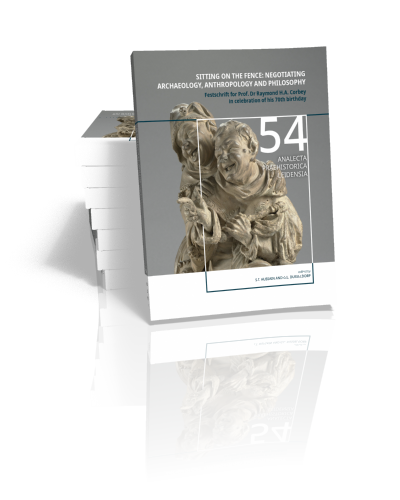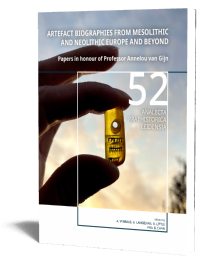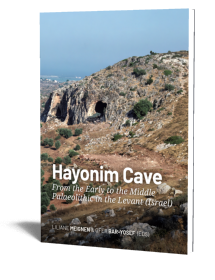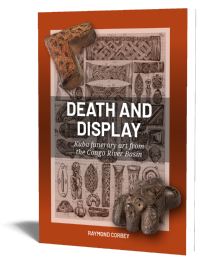Sitting on the fence: Negotiating archaeology, anthropology and philosophy
Festschrift for Prof. Dr Raymond H.A. Corbey in celebration of his 70th birthday
Edited by Shumon T. Hussain and Gerrit L. Dusseldorp | 2025

Sitting on the fence: Negotiating archaeology, anthropology and philosophy
Festschrift for Prof. Dr Raymond H.A. Corbey in celebration of his 70th birthday
Edited by Shumon T. Hussain and Gerrit L. Dusseldorp | 2025
Paperback ISBN: 9789464263206 | Hardback ISBN: 9789464263213 | Imprint: Sidestone Press | Format: 210x265mm | 236 pp. | Analecta Praehistorica Leidensia 54 | Series: Analecta | Language: English | 7 illus. (bw) | 22 illus. (fc) | Keywords: human origins; archaeology; philosophy of science; anthropology; human evolution; science in practice; epistemology; heritage; Indigenous art | download cover | DOI: 10.59641/uu901xg | CC-license: CC BY-NC-ND 4.0
Read online 210 times
- Digital & Online access
-
Buy via Sidestone (EU & UK)
-
Buy via our Distributors (WORLD)
For non-EU or UK destinations you can buy our books via our international distributors. Although prices may vary this will ensure speedy delivery and reduction in shipping costs or import tax. But you can also order with us directly via the module above.
UK international distributor
USA international distributor
-
Bookinfo
Paperback ISBN: 9789464263206 | Hardback ISBN: 9789464263213 | Imprint: Sidestone Press | Format: 210x265mm | 236 pp. | Analecta Praehistorica Leidensia 54 | Series: Analecta | Language: English | 7 illus. (bw) | 22 illus. (fc) | Keywords: human origins; archaeology; philosophy of science; anthropology; human evolution; science in practice; epistemology; heritage; Indigenous art | download cover | DOI: 10.59641/uu901xg | CC-license: CC BY-NC-ND 4.0
Read online 210 times

We will plant a tree for each order containing a paperback or hardback book via OneTreePlanted.org.
This volume celebrates the academic life of prof. Raymond Corbey. It gathers contributions by diverse scholars and professionals from both science and society to engage with a range of key topics Raymond has grappled with at different stages of his capricious career. The volume not only provides an opinionated portrait of Raymond as an academic persona and sometimes controversial scholarly figure, unpacking key tropes of his intellectual journey such as “sitting on the fence” or the “embedded philosopher” and academic “jester”, it also illustrates the wide-ranging and inspirational nature of his work. As a “boundary-worker” seeking to re-negotiate the limits, opportunities and contributions of various disciplines, the volume reflects Raymond’s critical but always provocative engagement with issues such as theory-building, alien civilizations and cosmic evolution, nonhuman sentience, the politics of species, Darwinism, the Maussian gift, human nature, hand axes, the mark of the intentional, diamonds, the structure of the European Mousterian, the relation between cultural anthropology and archaeology, liminality and the marginal, ritual and religion, cats, primates, language, heritage and the many legacies of Western thinking and acting in the world. Taken together, these individual contributions showcase the immense scope – temporal, geographic and topical – that defines Raymond’s unique scholarly venture which continues to animate many of his friends, colleagues and former students.
The volume will be of interest for a broad readership in academia and beyond, and for the first time brings poignant essays from philosophy to archaeology into conversation, which comment on, continue, or critique the scholarship Raymond embodies. This scholarship defies the contemporary tendency of hyper-specialization, and sometimes scholasticism, and inspires us to transcend the self-erected boundaries of academic and public cathedrals in our thinking and acting alike.
Raymond Corbey: A philosophical thorn in the side of archaeologists and much more
Gerrit L. Dusseldorp & Shumon T. Hussain
Towards an archaeology of an epistemologist’s epistemology
Wil Roebroeks
Raymond Corbey, the embedded philosopher sitting on the fence: making sense of a unique academic pursuit
Shumon T. Hussain
Better divergent than aligning: An argument in favour of the ‘shaken-bookcase syndrome’ in archaeological theory-building
Alex Geurds
Why, throughout the universe, reason and ‘civilization’ are more the exception than the rule
Pouwel Slurink
Psychic plants: A critique on Helmut Plessner’s plant-animal boundary
Norbert Peeters
Challenging the human-nonhuman boundary: biological and cultural diversity
Annette Lanjouw
Epistemology on Acid: Is Darwinism really such a dangerous idea?
Angus Mol
Homo sapiens, the four elements and the Anthropocene
Corrie Bakels
‘Intentions do not fossilize’ – Unpacking persistent but problematic domain-assumptions in Pleistocene lithic studies
Shumon T. Hussain
Hand Axes as Hyena Jaws
Jan Kolen
Bone hammers: Efficient but rare
Thijs van Kolfschoten
Diamonds are an early 20th century archaeologist’s best friend – On the interactions between diamond mining and Acheulean archaeology
Gerrit L. Dusseldorp
On Mousterian, Micoquian, and the origin of new Neanderthals in Western Europe ~70,000 years ago
Philip van Peer
Religious sacrifice in the Ice Age? Ritual finger amputation and the Gravettian hand images with incomplete fingers
Mark Collard & Brea McCauley
Three for playing, three for straying and three for staying. Exploring the changing role of cats in Pleistocene and Holocene Europe
Luc Amkreutz
Rediscovering the archaeological terrain
Dimitri DeLoecker & Jan Kolen
Locating and analysing the Marginal in Archaeology
John Bintliff
Is there a Western telos and is it in danger? A rationalist critique of some recent challenges to the social sciences and humanities
Jon Abbink
What Language Are We Speaking Here? Λογος in a Post-Humanist Climate
Joep Leerssen

Dr. Gerrit L. Dusseldorp
Gerrit L. Dusseldorp is a Stone Age archaeologist focussing on Pleistocene societies in both Europe and Southern Africa. His PhD work on Neanderthal foraging behaviour was co-supervised by Prof. Corbey. He currently directs work on the Middle to Later Stone Age transition Umhlatuzana rockshelter, South Africa. He is also involved in the multidisciplinary project “Liveable Planet” to develop strategies to develop more sustainable human societies. He is currently appointed as associate professor at the Faculty of Archaeology at Leiden University and as senior research fellow at the Paleo-Research Institute at the University of Johannesburg.

Dr. Shumon T. Hussain
Shumon T. Hussain is a transdisciplinary archaeologist with a research focus on Late Pleistocene and Early Holocene foragers, especially their stone artefact technologies and animal relationships. He is broadly interested in theoretical innovation and synthesis beyond archaeology as a disciplinary specialism, to better integrate data and perspectives across the humanities and sciences vis-à-vis question of the human deep past, and the epistemology and practice of science. He is currently based at the University of Cologne, Germany, where he is a senior researcher and lecturer at the newly established research hub MESH – Multidisciplinary Environmental Studies in the Humanities.
Abstract:
This volume celebrates the academic life of prof. Raymond Corbey. It gathers contributions by diverse scholars and professionals from both science and society to engage with a range of key topics Raymond has grappled with at different stages of his capricious career. The volume not only provides an opinionated portrait of Raymond as an academic persona and sometimes controversial scholarly figure, unpacking key tropes of his intellectual journey such as “sitting on the fence” or the “embedded philosopher” and academic “jester”, it also illustrates the wide-ranging and inspirational nature of his work. As a “boundary-worker” seeking to re-negotiate the limits, opportunities and contributions of various disciplines, the volume reflects Raymond’s critical but always provocative engagement with issues such as theory-building, alien civilizations and cosmic evolution, nonhuman sentience, the politics of species, Darwinism, the Maussian gift, human nature, hand axes, the mark of the intentional, diamonds, the structure of the European Mousterian, the relation between cultural anthropology and archaeology, liminality and the marginal, ritual and religion, cats, primates, language, heritage and the many legacies of Western thinking and acting in the world. Taken together, these individual contributions showcase the immense scope – temporal, geographic and topical – that defines Raymond’s unique scholarly venture which continues to animate many of his friends, colleagues and former students.
The volume will be of interest for a broad readership in academia and beyond, and for the first time brings poignant essays from philosophy to archaeology into conversation, which comment on, continue, or critique the scholarship Raymond embodies. This scholarship defies the contemporary tendency of hyper-specialization, and sometimes scholasticism, and inspires us to transcend the self-erected boundaries of academic and public cathedrals in our thinking and acting alike.
Contents
Raymond Corbey: A philosophical thorn in the side of archaeologists and much more
Gerrit L. Dusseldorp & Shumon T. Hussain
Towards an archaeology of an epistemologist’s epistemology
Wil Roebroeks
Raymond Corbey, the embedded philosopher sitting on the fence: making sense of a unique academic pursuit
Shumon T. Hussain
Better divergent than aligning: An argument in favour of the ‘shaken-bookcase syndrome’ in archaeological theory-building
Alex Geurds
Why, throughout the universe, reason and ‘civilization’ are more the exception than the rule
Pouwel Slurink
Psychic plants: A critique on Helmut Plessner’s plant-animal boundary
Norbert Peeters
Challenging the human-nonhuman boundary: biological and cultural diversity
Annette Lanjouw
Epistemology on Acid: Is Darwinism really such a dangerous idea?
Angus Mol
Homo sapiens, the four elements and the Anthropocene
Corrie Bakels
‘Intentions do not fossilize’ – Unpacking persistent but problematic domain-assumptions in Pleistocene lithic studies
Shumon T. Hussain
Hand Axes as Hyena Jaws
Jan Kolen
Bone hammers: Efficient but rare
Thijs van Kolfschoten
Diamonds are an early 20th century archaeologist’s best friend – On the interactions between diamond mining and Acheulean archaeology
Gerrit L. Dusseldorp
On Mousterian, Micoquian, and the origin of new Neanderthals in Western Europe ~70,000 years ago
Philip van Peer
Religious sacrifice in the Ice Age? Ritual finger amputation and the Gravettian hand images with incomplete fingers
Mark Collard & Brea McCauley
Three for playing, three for straying and three for staying. Exploring the changing role of cats in Pleistocene and Holocene Europe
Luc Amkreutz
Rediscovering the archaeological terrain
Dimitri DeLoecker & Jan Kolen
Locating and analysing the Marginal in Archaeology
John Bintliff
Is there a Western telos and is it in danger? A rationalist critique of some recent challenges to the social sciences and humanities
Jon Abbink
What Language Are We Speaking Here? Λογος in a Post-Humanist Climate
Joep Leerssen

Dr. Gerrit L. Dusseldorp
Gerrit L. Dusseldorp is a Stone Age archaeologist focussing on Pleistocene societies in both Europe and Southern Africa. His PhD work on Neanderthal foraging behaviour was co-supervised by Prof. Corbey. He currently directs work on the Middle to Later Stone Age transition Umhlatuzana rockshelter, South Africa. He is also involved in the multidisciplinary project “Liveable Planet” to develop strategies to develop more sustainable human societies. He is currently appointed as associate professor at the Faculty of Archaeology at Leiden University and as senior research fellow at the Paleo-Research Institute at the University of Johannesburg.

Dr. Shumon T. Hussain
Shumon T. Hussain is a transdisciplinary archaeologist with a research focus on Late Pleistocene and Early Holocene foragers, especially their stone artefact technologies and animal relationships. He is broadly interested in theoretical innovation and synthesis beyond archaeology as a disciplinary specialism, to better integrate data and perspectives across the humanities and sciences vis-à-vis question of the human deep past, and the epistemology and practice of science. He is currently based at the University of Cologne, Germany, where he is a senior researcher and lecturer at the newly established research hub MESH – Multidisciplinary Environmental Studies in the Humanities.
- Digital & Online access
-
Buy via Sidestone (EU & UK)
-
Buy via our Distributors (WORLD)
For non-EU or UK destinations you can buy our books via our international distributors. Although prices may vary this will ensure speedy delivery and reduction in shipping costs or import tax. But you can also order with us directly via the module above.
UK international distributor
USA international distributor
- Browse all books by subject
-
Search all books

We will plant a tree for each order containing a paperback or hardback book via OneTreePlanted.org.
You might also like:
© 2025 Sidestone Press KvK nr. 28114891 Privacy policy Sidestone Newsletter Terms and Conditions (Dutch)








